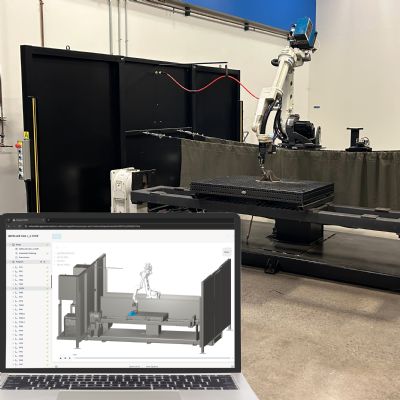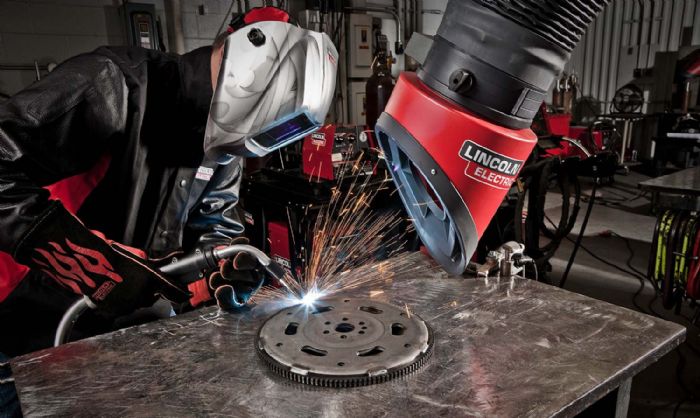Preferably, weld tool steels in the annealed condition, although performing an annealing treatment as a preparation for welding may not be possible in some cases.
SMAW Ideal for Tool-Steel Welding
Shielded-metal-arc welding (SMAW) offers the most advantages in welding tool steel. These advantages include a large selection of available filler materials, and the fact that SMAW is a versatile process. In addition, the solid slag shielding provides adequate protection and may retard cooling—a favorable feature.
Disadvantages of other gas-shielded processes for tool-steel welding include frequent interruption for changing electrodes, the need for slag chipping and cleaning, difficulty in maintaining preheat temperature, peening requirements, and variability of results.
When employing SMAW for tool steel, follow these recommendations:
- Select the smallest-sized electrode for the job.
- Prepare the tool surface with machining or grinding, with rounded side grooves presenting a joint angle of at least 30 deg. and a bottom width greater than the electrode diameter.
- For crack repair, drill stop holes at both ends and machine away the entire cracked portion.
- For edge building or rebuilding, using a support copper or graphite bar to contain the molten filler metal may prove advantageous.
- Absolute cleanliness of the work material and electrodes is essential, as is the dryness of the electrode cover.
- Use the lowest heat input possible and decrease for successive passes.
- If possible, position the work at a slight uphill inclination to improve weld penetration.
- Always perform preheating, possibly in a furnace or in a specially built insulated preheat box.
- Deposit narrow beads and remove slag by chipping and brushing between passes.
- Use light peening on the hot weld to relieve stresses.
Tips on Filler Metal Selection
When determining the most-appropriate filler to use when welding tool steel, consider the base-metal composition (from the tool-steel designation), tool condition (if annealed or hardened) and the service requirements of the welded area. Note that selecting a filler composition similar to that of the base metal proves more important when welding annealed tool steels. Welds should respond equally well to heat treatment provided that that the hardness is comparable to that developed by the base metal. Filler metal selection proves more difficult when welding tool steel in a hardened condition, but offers a larger range of possible filler materials.
Given a limited volume of area to be repaired, use a filler material that self-hardens upon cooling, even though its composition may be quite different from that of the base metal. And, should welding be required in a nonworking area of the tool, the welder has a larger selection of either low-alloy or stainless steels to use as filler.
While the recommendations outlined provide help, unfortunately, a straightforward and comprehensive table showing us which exact filler to use and when to use it simply does not exist. Part of the problem: Many tool steels are proprietary to their manufacturers, with particular material characteristics not available to those who use and repair them. Also adding to the challenge of tool-steel weld repair: Tooling applications and requirements vary greatly, necessitating unique repair approaches, even on the same tool steel.
While this article provides valuable advice, the best course of action in assessing and performing tool-steel repair may be to recruit the services of professionals (i.e., metallurgical experts) on both the tool-steel and filler-material sides. MF
This article was excerpted from www.welding-advisers.com, which provides practical information on a wealth of welding topics.
View Glossary of Metalforming Terms
Technologies: Tooling, Welding and Joining
Comments
Must be logged in to post a comment. Sign in or Create an Account
There are no comments posted. Welding and Joining
Welding and JoiningPartnership Promotes AI-Powered Welding Automation
Wednesday, May 7, 2025
 Welding and Joining
Welding and JoiningOffline Programming for Miller’s PerformArc Robotic-Welding ...
Friday, March 14, 2025
 Welding and Joining
Welding and JoiningMiller Electric and Novarc Partner to Bring AI to Cobot Weld...
Tuesday, February 25, 2025






 Why such challenges, and how can they be overcome? Answering these questions starts with the definition of tool steel. Tool steels, iron-based alloys of special composition, usually are grouped according to their most important functions. Cold-worked tool steel, used for punches, shearing blades and forming tools, may be made of any one of the tool steels identified by the quenching medium used to develop hardness, listed here in the order of increasing hardenability: water-hardening (Wx, where x is a serial number); oil-hardening (Ox, as above); air-hardening (Ax and Dx); and shock-resisting, used for hammers, chisels, etc. (Sx, where x denotes a serial number).
Why such challenges, and how can they be overcome? Answering these questions starts with the definition of tool steel. Tool steels, iron-based alloys of special composition, usually are grouped according to their most important functions. Cold-worked tool steel, used for punches, shearing blades and forming tools, may be made of any one of the tool steels identified by the quenching medium used to develop hardness, listed here in the order of increasing hardenability: water-hardening (Wx, where x is a serial number); oil-hardening (Ox, as above); air-hardening (Ax and Dx); and shock-resisting, used for hammers, chisels, etc. (Sx, where x denotes a serial number).